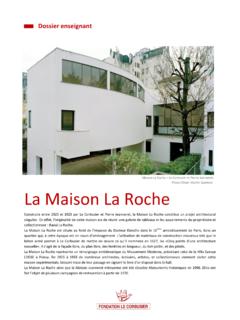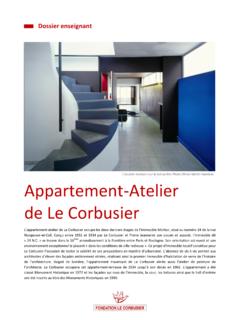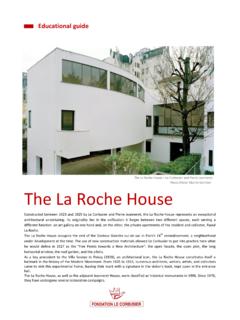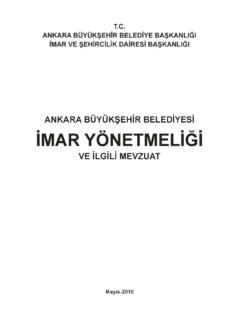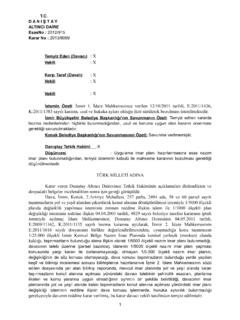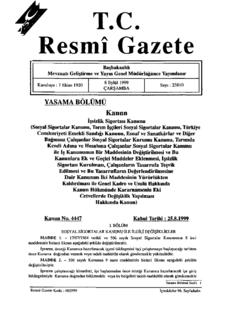Transcription of Studio-Apartment - Fondation Le Corbusier
1 Maison La Roche 1 Staircase leading to the roof garden. Photo Olivier Martin-Gambier Educational guide Le Corbusier s Studio-Apartment Le Corbusier s Studio-Apartment occupies the last two floors of the Molitor apartment block, located at 24, rue Nungesser et Coli. Designed between 1931 and 1934 by Le Corbusier and Pierre Jeanneret, his cousin and associate, the building called 24 is situated in the 16th arrondissement at the border between Paris and Boulogne. Due to its East-west orientation and its exceptional surroundings, it fits what Le Corbusier termed the conditions of the radiant city . As a project for a rental building, it offered the architect the opportunity to test the validity of his urban proposals.
2 Given that no structures were placed opposite, he could raise facades entirely filled with windows, thereby constructing the first residential apartment made of glass in architectural history. Bathed in light, Le Corbusier s personal apartment spans the length of the last floor and, furthermore, houses his painting studio . The architect would inhabit this apartment -terrace from 1934 until his death in 1965. The apartment was classified as a Historical Monument in 1972, and the facades facing the streets, the courtyard, the roof, and the entrance hall were also inscribed as such in 1990. apartment Block 24 2 Portrait of Le Corbusier The architect and property developer The architect: Born Charles-Edouard Jeanneret, Le Corbusier (1887-1965), left his birthplace, La Chaux-de-Fonds in Switzerland, in 1917 and settled definitively in Paris.
3 His teacher, Charles L Eplattenier, played a critical role in his creative education. Le Corbusier explained: One of my teachers (a very remarkable man) gently dissuaded me from the choice of a mediocre career. He wanted to turn me into an architect. I loathed architecture and As I was only sixteen, I accepted his verdict and obeyed his edict: I took up architecture. 1 Between 1907 and 1911, Le Corbusier made a certain number of tours in Italy, Germany, and the Orient to study art and architecture. As an architect, urban planner, painter, and writer, he conducted various studies on artistic creation and the modern habitat.
4 In 1923, he published Towards an Architecture, which remains today one of the iconic references of Modern Movement*. By 1931, Le Corbusier enjoyed a certain notoriety, having already constructed a number of buildings in Paris and its provinces: the Cit Frug s in Pessac, the Esprit Nouveau pavilion, the Salvation Army Cit de Refuge, and Swiss pavilion in Paris; the Villa Savoye in The property developers: In 1931, the Soci t Immobili re de Paris Parc des Princes (the Parc des Princes Real-Estate Society of Paris), represented by Marc Kouznetzoff and Guy Noble, had recently acquired a plot of land in the West of Paris, just next to Boulogne.
5 The terrain was part of a new neighborhood under development at the time. In June of that year, Le Corbusier and his cousin, Pierre Jeanneret, received a commission to construct an apartment building on this parcel of land. Given that they were unable to gather the entirety of the funds necessary for the project, the property developers teamed with the architects to find within a guaranteed purchasers for at least two and half floors . 2 of the future building. Le Corbusier immediately looked to his circle of relations for potential buyers. Moreover, he intended to prove to the developers that the avant-garde nature of the project could draw an interest superior to that the neighboring, more traditional buildings.
6 THEMES The role of the architect (to build and to manage the space) The architectural commission, the patron The architect, his patron A communal residence BEFORE THE VISIT Le Corbusier The Bauhaus, Walter Gropius The Modern Movement: - Alvar Aalto - Mallet-Stevens - Mies van der Rohe - Piet Mondrian - Th o Van Doesburg Docomomo France (documents on the architecture of the Modern Movement) AFTER THE VISIT Modern housing Architecture inscribed or classified as a Historical Monument The communal apartment block HISTORICAL PERIODS The 20th century and our age ART HISTORY Spatial arts Daily arts Visual arts NOTE.
7 Le Corbusier is cited as an example in the reference list for the communal habitat (Cit radieuse/radiant city) and for sacred architecture (the chapel at Ronchamp) apartment Block 24 3 Location map The commission and construction site Location: The apartment block at 24, rue Nungesser et Coli is located at the periphery of Paris, between the 16th arrondissement and the commune of Boulogne. The terrain allotted to its construction follows an East-west orientation, allowing for an ideal exposure to the sun. Le Corbusier went so far as to name it one of the finest sites in Paris, 4 since no building faces or obstructs it and, at the upper levels, it offers a unique view of the woods of Boulogne.
8 On the side facing Paris, the apartment looks onto the Jean Bouin stadium, the lease of which registered with the State for a duration of ninety-nine years. It s likely that Le Corbusier accepted to build this edifice precisely because the site possessed so many of the qualities he deemed key to the Radiant City . The project: The Soci t Immobili re de Paris Parc des Princes solicited from Le Corbusier and Pierre Jeanneret a building plan that would house roughly fifteen apartments to be sold or rented. Following this program*, the architects designed a structure comprising two or three apartments per level.
9 The final plan read as follows: three housing units on each of the first two floors as well as the fourth and fifth, and two on the third and sixth floors. Le Corbusier negotiated with the property developers so as to obtain the last two levels of the building and use them for his own apartment . Having secured the seventh and eighth floors, the architect set himself to the construction, at his own expense, of these two levels and the roof of the building. THEMES The building and its terrain Construction procedures Principles of the Radiant City BEFORE THE VISIT The architectural project The construction The structure The Radiant City AFTER THE VISIT Architectural art The site today, the site in 1931 Urbanism The Radiant City From 1931 to 1933, Le Corbusier drafted The Radiant City.
10 In the text, he summarized its basic principles as follows: The basic materials of city planning are: sun, sky, trees, steel, cement in that strict order of importance. 3 The residents of such a city benefit from what he therein termed the essential joys of modern living. The apartment block at 24 was constructed according to these principles and exemplifies the application of this doctrine on an urban scale. apartment Block 24 4 Promotional brochure of the Soci t Immobili re de Paris As the promotional brochure of the Soci t Immobili re de Paris Parc des Princes emphasizes, several sport complexes would surround the future Molitor building: the Jean Bouin and Rolland Garros stadiums, the Parc des Princes velodrome, tennis courts, a This athletic environment, in close proximity to the building, would ultimately determine its clientele.
